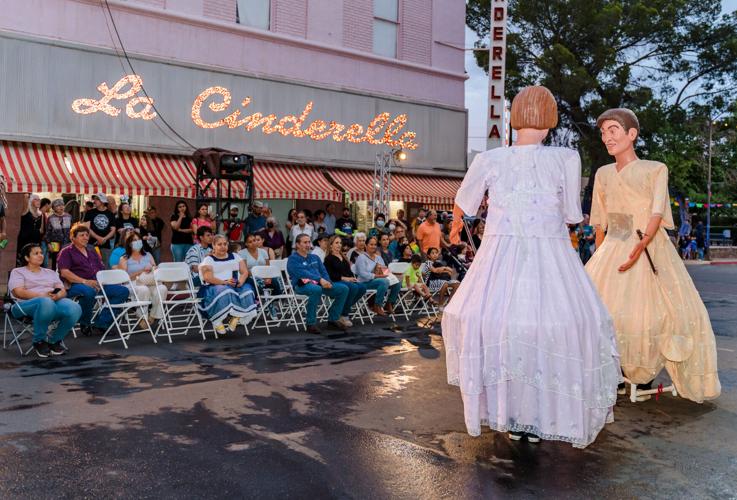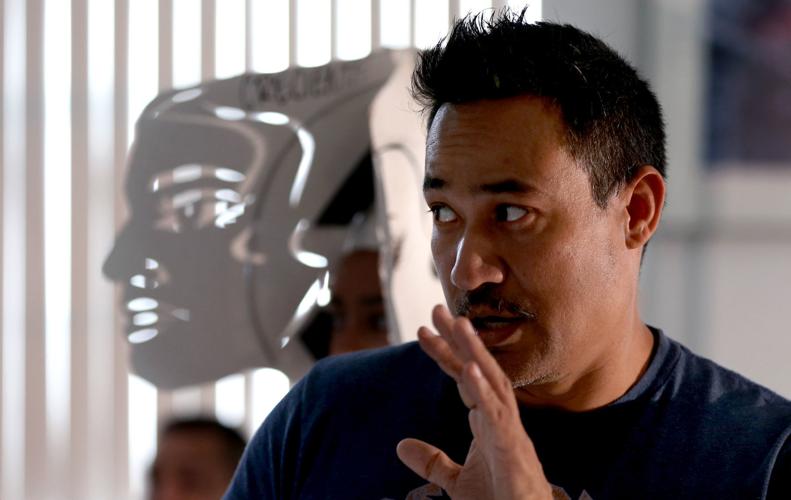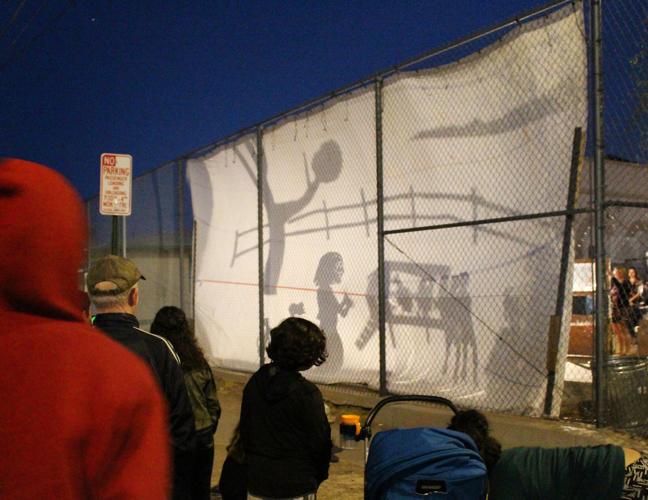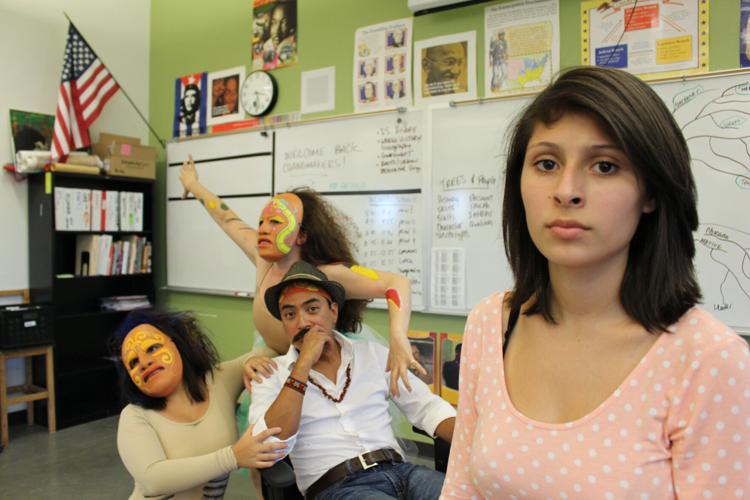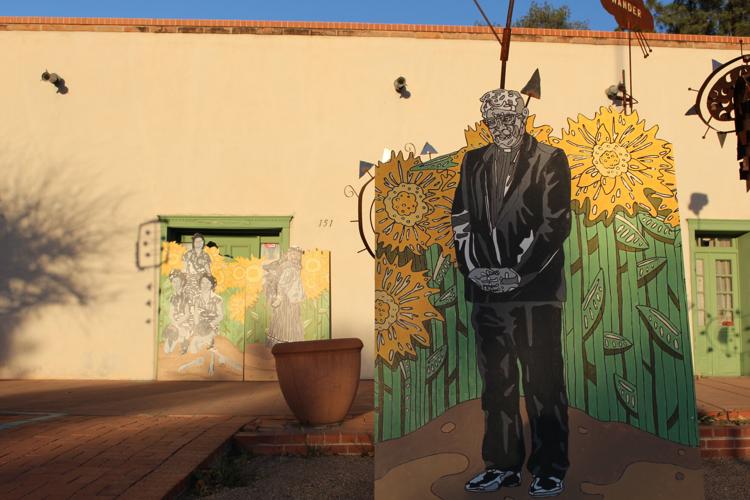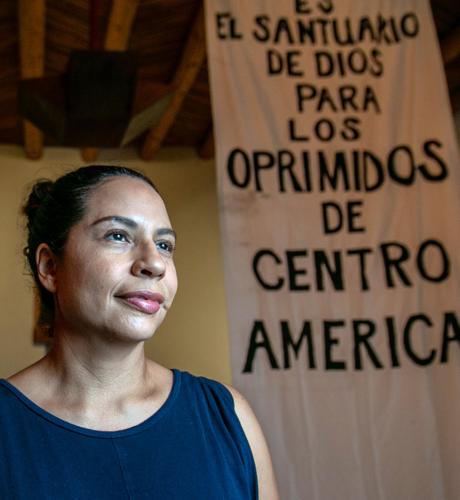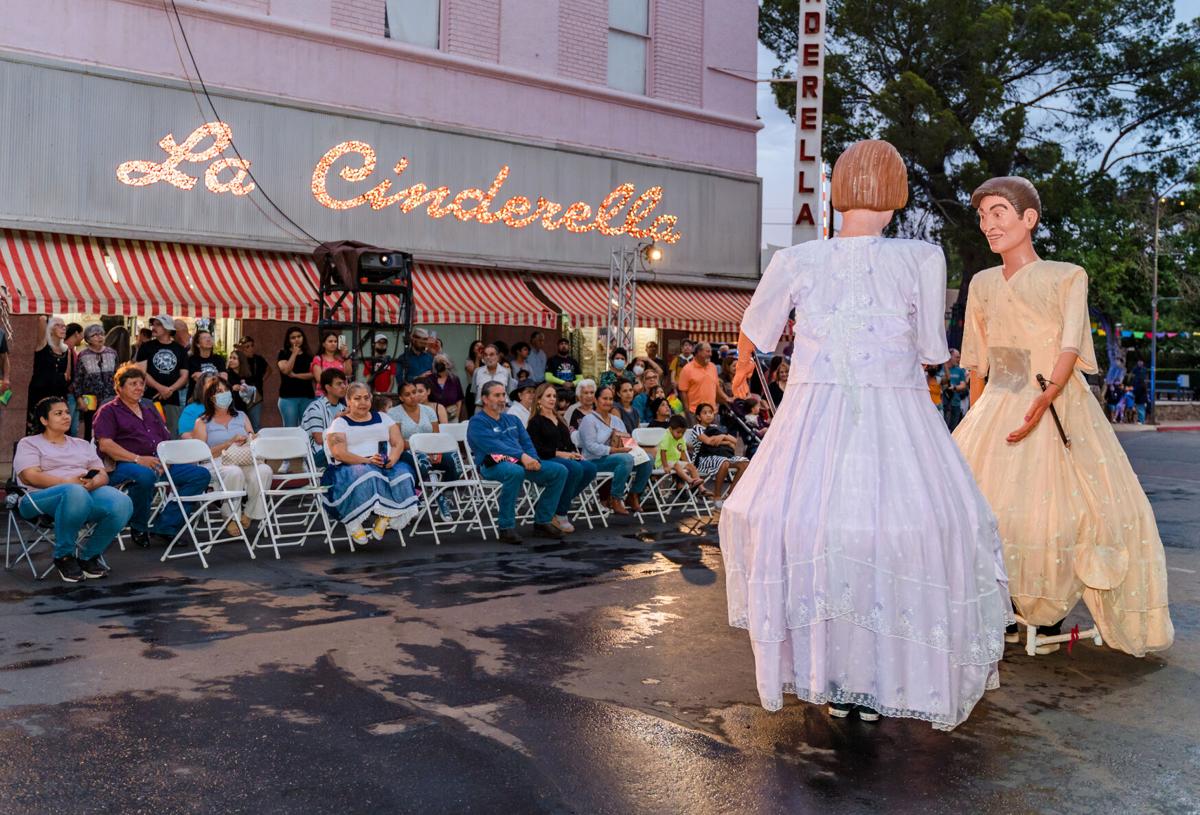When Marc David Pinate and Milta Ortiz became the directors of Borderlands Theater, they weren’t looking to be awarded any national or international recognitions. They were looking to bring rich stories of Tucson’s barrios to life, and to connect with the community in a way that hadn’t been done before.
It’s been over eight years of hard work for the couple, and although recognition was never the ultimate goal, last year they were awarded the 2022 Outstanding Theater Award by the National Theatre Conference. The award is nomination-based and recognizes the hard work and achievements made by a nonprofit theater.
“The person that nominated us, Robert Schenkkan, is a Tony Award-winning playwright and screenwriter,” Pinate said. “Back in 2017, we produced a play of his called ‘Building the Wall.’ He came for opening night, had a dinner with us and then left. We didn’t think anything of it.”
But behind the scenes, Schenkkan followed the theater’s career and was able to see the impact its works had on the Tucson community. It was this that led him to write his nominating letter stating that, “For over 30 years, Borderlands has been making important theater, locally-sourced, but of national import.”
“Locally-sourced, but of national import.” This here is at the core of what Borderlands Theater has become since Pinate and Ortiz took over in 2014.
Before becoming a director, Pinate was finishing grad school in Chicago, and the theater was run by Barclay Goldsmith, who founded Borderlands in 1986. Goldsmith’s early theater developed out of a community-based collective in Tucson called Teatro Libertad, which began in the 1970s. But from an activism-based collective, Borderlands shifted into a playwright focused theater and produced around four plays a season. They were all still focused on community issues and supporting the work of Chicano and other people of color. As amazing as this was, Borderlands was having financial difficulties, according to Pinate.
Goldsmith’s relationship with Pinate and Ortiz began after the couple was finishing grad school and found out about controversy within Tucson’s largest school district over the study of Mexican-American history. They reached out to Goldsmith about creating a docudrama chronicling the events and after Pinate and Ortiz finished their masters in 2013, they came to Tucson to work on it.

Director Milta Ortiz and Marc David Pinate’s Borderlands Theater has been recognized with the 2022 Outstanding Theater award from the National Theatre Conference.
“With my family roots being very deep in Arizona and with our expertise in the field, he (Goldsmith) saw us as an amazing option for people to take over the program,” Pinate said. “The theater felt we could take the best step forward…”
… “and they were right,” Ortiz added. “We tried to do it the way they had done it and it was killing us. It was challenging to produce four plays, and on top of that do the site-specific work we loved.”
The couple started out by staying true to the four-play system, but they realized that the community responded much better to plays like “Más,” which was the original work about Tucson Unified School District that Pinate and Ortiz came to Tucson to create in 2013.
“That’s what brought out this diverse community we were after,” Ortiz said. “So, after some time we decided to focus on our work like the barrio stories, which have been very successful for us. We produce one to two projects a year, which are the Barrio Stories.”
Reactivating communities
The Barrio Stories project was created by Borderlands Theater in 2015. It’s an ongoing site-specific series intended to preserve and reflect the stories, people and places that made Tucson barrios so vital to the cultural fabric of the Southwest. The first two iterations of the Barrio Stories were about Barrio Viejo and Barrio Anita.
The truly amazing thing about this project is that so far, not only have the works about Barrio Viejo and Barrio Anita brought art and theater to communities, they also have both been the catalyst for a re-activation of space and have led to tangible wins for Mexican-American activism.
Their Barrio Viejo work, which was produced in March 2016, was an immersive experience for the viewers in which they heard and saw the stories of elders from the community that lived, worked and played there, which was a vibrant Mexican-American neighborhood that was demolished in the '60s to make way for an urban renewal project that led to the construction of the Tucson Convention Center.
This work took a lot of inspiration from a book by Tucson writer Lydia Otero called “La Calle.” Otero was a consultant for the project and was able to witness some of her words come to life through the performances. They inspired her to action. After years of working with the city and Mayor Regina Romero, she finally saw her work, and that of Pinate and Ortiz, pay off at the Alva Bustamante Torres Plaza renaming event just weeks ago on Dec. 9.
Otero’s work inspired Borderlands Theater, which then re-ignited Otero’s fire to advocate for the permanence of the work of Alva Torres, an activist for historic preservation of the old barrio in the ‘60s. A plaza at the TCC now bears her name and story of advocacy, and Dec. 9 will from here on be known as Alva Bustamante Torres Appreciation Day in Tucson.
“At the renaming event is the first time Otero said that they got the idea from the Borderlands project,” Pinate said. “From the $80,000 budget for the first Barrio Stories to a multimillion-dollar project by the city, that is huge.”
Being a true part of the community, connecting with them and connecting the people to city officials and sparking ideas. This is what Borderlands Theater has become under the guidance of Pinate and Ortiz.
Their second project, Barrio Stories in Barrio Anita, led to more immediate action after its production in 2018.

An audience watches “La Matadora,” a shadow puppetry play, adapted from Patricia Preciado Martin’s story by Milta Ortiz and directed by Marc David Pinate during a Barrio Stories, Barrio Anita event in April 2018.
During this time, Romero, who at the time was a council member for Ward 1, where Barrio Anita is located, was a crucial piece in the Borderlands project for the re-activation of community spaces in the barrio.
“I’ve always been a strong admirer of Borderlands Theater, and with Marc and Milta they brought new ideas about how to bring the theater and art into communities,” Romero said. “Creating these stories about our barrios, about the families and how they connect to Tucson and these lands.”
Pinate and Ortiz approached then-council member Romero about wanting to work with Barrio Anita, and Romero, knowing the work they had done with Barrio Viejo, didn’t hesitate to offer her help and support.
During this time in 2017-18, Barrio Anita was very divided. It wasn’t an active neighborhood and according to Romero, there was “in-fighting.” So, Romero got to work with members of the barrio to reactivate it and bring money in so they could reopen the neighborhood public swimming pool which had been closed since 2011.
“Marc and Milta presented me with their idea to work with the barrio, inform themselves of its history and collaborate with the neighbors in order to create a performance and presentation about the stories of the families of Barrio Anita, and its spaces,” Romero said.
This crucial beginning of a project is part of what makes the work that Borderlands produces so pure and reflective of the barrios it represents in its productions. It’s almost sacred.

Director Marc David Pinate gives stage directions during a rehearsal of the shadow theater segment of “Barrio Stories,” tales gathered from Barrio Anita.
“We start projects by conducting oral history interviews with people from the community,” Pinate said. “We put ourselves out there and let them know what we’re doing. We form a steering committee from the community and when we get a theme that we think will be good and relevant, we bring it up with them and they steer us in the right direction. We then create the play and have a free community reading and about 50-100 people come out and they give us their feedback and we go back to the drawing board to create our final script.”
“Each barrio’s story is different,” Ortiz adds. “And it’s these different stories that emerge that bring all these amazing ideas to the table for us to work with.”
So, they got to work. They met with neighbors, with city officials and used the help of Romero to stage their production in Barrio Anita.
“When the celebration took place, and Borderlands came together with the neighbors to present the show, they connected with Davis School, with the Oury Recreation Center, and the neighborhood began to once again recognize the importance of family history, the importance of the history in Barrio Anita,” Romero said.
Through creative-placemaking in theater, a community was re-activated into action and because of their efforts the Oury public pool reopened in 2019.

One of the mural panels that was created for Barrio Stories in Barrio Anita, organized by Borderlands Theater, is of Fr. Carrillo. It was designed by Wesley Creigh and painted by community members from Barrio Anita, the University of Arizona and Davis Elementary.
‘Creative placemaking’
Borderlands is a growing theater with more than its fair share of projects on the horizon.
This coming spring, Borderlands will present its Barrio Stories “Westside Stories,” which will focus on re-activating the Garden of Gethsemane in Menlo Park. In the winter, it will be Antigona 3.0, which will be a mix of the original but morphed into telling a story about living on the border.
It is also keeping in mind a project further in the future that will take place in Camp Naco, a border fort which was manned by the Buffalo soldiers. Many of the border forts, including Camp Naco, were decommissioned in the 1940s. A lot of them have fallen to decay, but since Camp Naco is an adobe build, it is still standing.
Despite its resilience, The Mellon Foundation recently found out the camp is in danger of disappearing. They approached the city of Bisbee to do a project involving the arts to revamp the camp so it can be a tourist attraction and remain relevant in history. The city of Bisbee then approached Helen Erikson, project director of the Heritage Conservation Program at the University of Arizona, to create something to bring awareness to the camp and its history. She made a website about Camp Naco and its connection to the Buffalo Soldiers, the indigenous folks and the Mexican revolution. The Mellon Foundation awarded the camp a $3.5 million grant for renovation and Borderlands Theater will be the first artists in residence. Pinate and Ortiz confirmed that production will begin in 2023, with the performance being shown in 2024.
On a personal note for Pinate, this spring he will begin teaching a class on creative placemaking at the University of Arizona to educate the new generation on creating connections for barrios and the tools they need to voice their stories.
“Creative placemaking is this idea where artists create partnerships with community members and city folks, using the tools of theater to facilitate the process of building relationships between neighborhoods and city officials to give the people a voice in what happens to their community,” Pinate said.
Pinate and Ortiz are both advocates for education, and together with city officials, they have a dream for Borderlands to become a place for education in the arts.
Another way of re-activating a space is by using it, and Romero wants Borderlands Theater to work with her and the city on re-activating the Pueblo Neighborhood Center into a space for them to create their work, bring together the Mexican-American and Chicano community of Tucson, and educate the youth of the community on how to voice their stories.

Cast members of Borderlands Theater's production of "Más," which highlighted the battle over Mexican American Studies in the Tucson Unified School District.
“One of the projects that is a dream of mine is having this Mexican and Chicano cultural center where we can study art,” Romero said. “Whether that be theater, music, literature or tamale making. I want to have a permanent space for Borderlands to do this work. It is a dream, but with Borderlands we have talked about it, and I do believe we can begin slowly taking steps to move forward.”
The center is already getting some action from Borderlands. They recently had a book launch there and will be doing the rehearsals for the “Westside Stories” there as well.
“A lot of what we do is about sharing joy together, joy and resistance, or joy as a revolutionary act,” Ortiz said. “The takeaway for me with the award we received is that we are doing what we love, and folks are recognizing that nationally, which is amazing. I don’t think it’s something that happens often in this world, and it makes me feel hopeful for change in the broader theater community.”
For more information about Borderlands Theater, click here.
Walking tour of the historic Barrio Viejo neighborhood south of downtown Tucson. Text by Bobbie Jo Buel. Photos by Mamta Popat. Produced by Rick Wiley / Arizona Daily Star 2020


